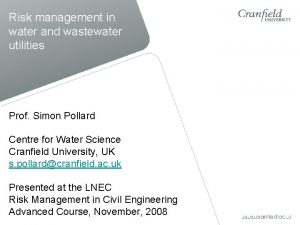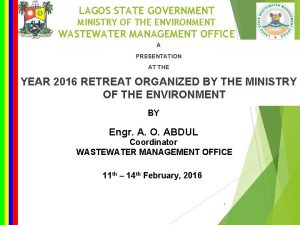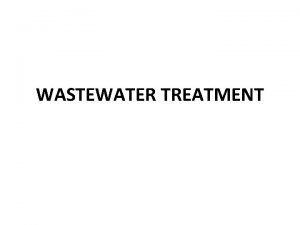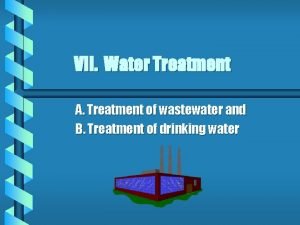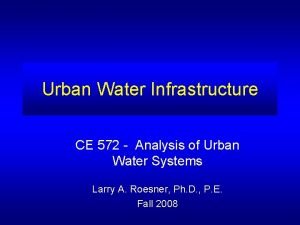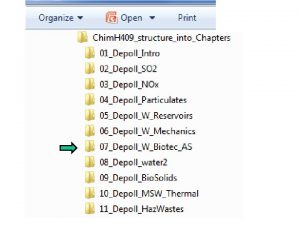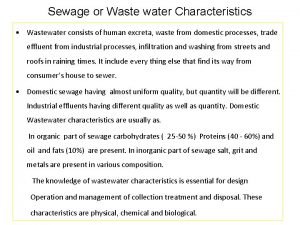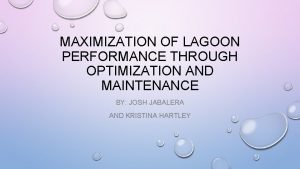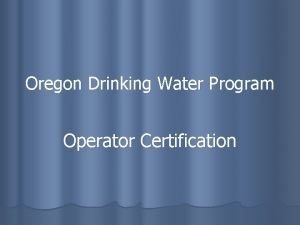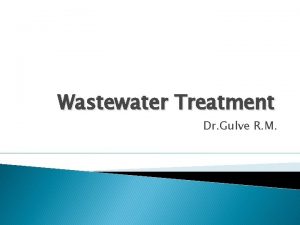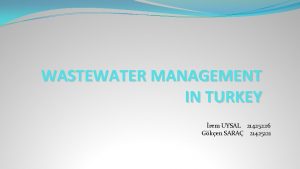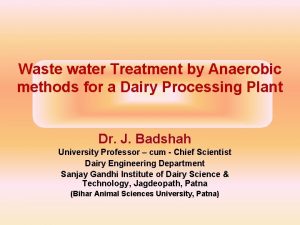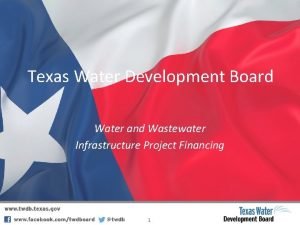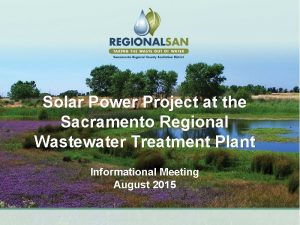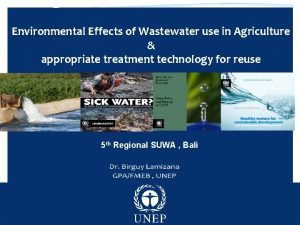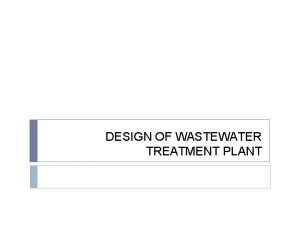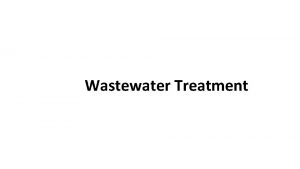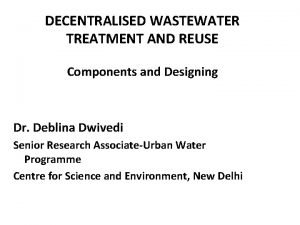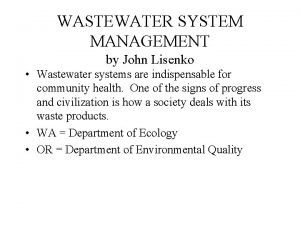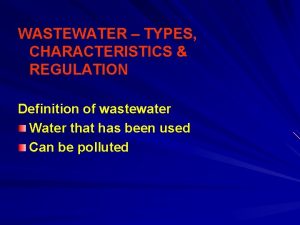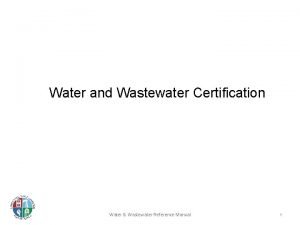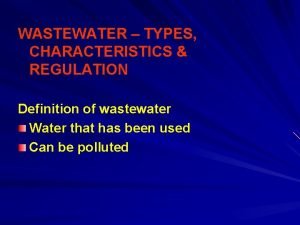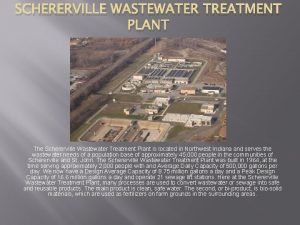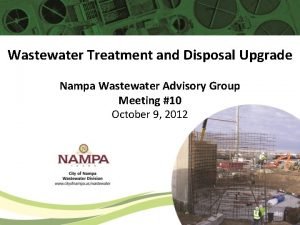Decentralised Wastewater Management Experiences from India M Starkl



















- Slides: 19

Decentralised Wastewater Management: Experiences from India M. Starkl* and A. Kazmi** * University of Natural Resources and Life Sciences, Vienna, Austria ** Indian Institute of Technology, Roorkee, India

Definitions n n largest solution: whole catchment area, smallest solution: single households, decentralized solutions inbetween fully centralized solutions hardly existing, large scale vs. small scale decentralized system

Lack of sanitation coverage Source: WHO and UNICEF 2012

Water quality in India Temperature, p. H, electrical conductivity, NH 3 -N, NO 3 – N, TDS, TP and FC Source: Kazmi et al. , 2013

Existing wastewater treatment in India n Water and wastewater market in India is expected to grow to 50 Billion EUR over the next 5 years (EBTC, 2013)

Evolution of sanitation policies in India National Urban Sanitation Policy (NUSP): 2008 Nirmal Gram Puraskar(NGP): 2003 Total Sanitation Campaign(TSC): 1999 Central Rural Sanitation Program (CRSP) : 1986 Emphasis on toilet construction: Supply driven, High subsidy, Departmental executed Emphasis on toilet construction: Range of options to promote increasing affordability, Demand responsive, Greater household involvement, Shift from high subsidy to low subsidy. Addition to TSC: Incentive scheme for fully sanitized and open defecation free Gram Panchayats Integrated Sustainable Approach: Water, Sanitation, Solid waste management and rain water harvesting included; Wastewater treatment

Wastewater treatment technologies in India ON-SITE SYSTEMS SMALL SCALE / DECENTRALISED SYSTEMS LARGE SCALE/ CENTRALISED SYSTEMS Biogas toilet system (Improved) Composting toilet Septic tank Single pit latrine Soak pit Two-pit latrine Urine diverting (dry) toilet system (UDDT) Anaerobic baffled reactor Anerobic filter Biogas digester Compact wastewater treatment plants Constructed wetlands (planted filters) Earthworm technology Floating aquatic plant systems (duckweed, water hyacinth) Karnal technology Waste stabilization ponds Activated sludge process Aerated lagoon Extended Aeration Fluidized Aerobic Bed Sequencing Batch Reactor Trickling filter Upflow anerobic sludge blanket (UASB) Waste stabilization ponds

Existing WWTPs in India

Survey of small scale plants below 5 MLD

Decentralized wastewater treatment plants in Delhi

Decentralized wastewater treatment plants in Delhi

Wastewater treatment in Delhi Technology Activated Sludge Process Aerobic treatment Anaerobic hybrid reactor BIOFOR Biogas plants with effluent treatment system (filtration, UV) BORDA type DEWATS Constructed wetland (CW) Duckweed Pond Extended aeration Fluidized Aerobic Bed Fluidized Media Reactor Membrane Bioreactor Micro STP New Generation Package Treatment Plants Package Contact Aeration Plants Package Advanced on-site systems Submerged Aerobic Fixed Film (SAFF) Waste stabilization pond All technologies No of Plant s 12 1 2 3 Capacity (MLD) 2052. 21 0. 50 201. 6 1 - 3 3 1 2 2 15 1 10 4 5 22 1 1 89 0. 08 45. 4 6. 0 3. 55 4. 54 0. 154 0. 14 2. 0 27. 27 2343. 59

Performance of 18 STP in Delhi Capacity No. of Technology Status STPs MLD Plants used Satisfactory Poor Very poor 0 -10 (small) 6 FAB (1), SAF (1), Biofor (2), Micro STP (2) 1 3 2 11 -50 (medium) 3 extended aeration (2), ASP (1) 1 1 1 2 ASP(2) 2 7 ASP(6), Biofor (1) 3 51 -100 (large) 101 -700 (very large) Source: CPCB, 2007: of 18 4 Evaluated

Why do many decentralised wastewater treatment plants not work? n Solutions not adapted to local situation n n Weak n n n Lack of financial capacity Lack of technical capacity Lack of stakeholder/user support Regulation Operation Monitoring Enforcement Detailed evaluation currently ongoing!

Need of integrated planning aproach: POSAF • POSAF: Planning Oriented Sustainability Assessment Framework • Scientific basis published in Water research (in press) • Currently applied for implementation of City Sanitation Plan in India

Strengths, Weaknesses, Opportunities and Threats of decentralized off-site solutions STRENGTHS • low/no energy requirements • benefit of side products • incoming wastewater volumes and reuse easier to manage than for large scale systems • smaller solutions affordable and faster to implement OPPORTUNITIES • potential for rural & peri-urban areas, small towns • increased use of side products possible • adaption to local conditions and requirements possible WEAKNESSES • economies of scale may favour large solutions • many small treatment plants need more efforts for managment • less comfortable than centralised systems (depending on technology) • higher user responsibility required THREATS • improper O&M arrangement can endanger functioning • located near or within human settlements → possible odour, overflow, aesthetic issues

Conclusions n n n India has considerable experience with small and large scale (decentralized) wastewater treatment plants Major problem is operation and maintenance Lack of monitoring and documentation of performance of in particular smaller scale plants – actual performance not known Operators even reluctant to provide access and share existing data Independent evaluation of plants required

THANK YOU!

Acknowledgements n Project SARASWATI (Supporting consolidation, replication and up-scaling of sustainable wastewater treatment and reuse technologies for India) Project supported by the European Commission’s FP 7 (Grant Number 308672) and DST, GOI under EU-India cooperation in water technology: research and innovation
 Comparative development experiences of india and china
Comparative development experiences of india and china Risk management for water and wastewater utilities
Risk management for water and wastewater utilities Lagos state wastewater management office
Lagos state wastewater management office Wastewater treatment purpose
Wastewater treatment purpose Aquaculture water treatment
Aquaculture water treatment Wastewater treatment process primary secondary tertiary
Wastewater treatment process primary secondary tertiary Wastewater distribution system
Wastewater distribution system Typical composition of untreated domestic wastewater
Typical composition of untreated domestic wastewater Physical characteristics of sewage
Physical characteristics of sewage Winter lagoon optimization
Winter lagoon optimization Ashbridges bay treatment plant
Ashbridges bay treatment plant Oregon drinking water program
Oregon drinking water program Peak hourly flow wastewater
Peak hourly flow wastewater Municipal wastewater treatment
Municipal wastewater treatment Agricultural wastewater treatment technologies
Agricultural wastewater treatment technologies Anaerobic wastewater treatment
Anaerobic wastewater treatment Wastewater infrastructure design in texas
Wastewater infrastructure design in texas Sacramento regional wastewater treatment plant
Sacramento regional wastewater treatment plant Agricultural wastewater treatment technologies
Agricultural wastewater treatment technologies Primary detention
Primary detention

